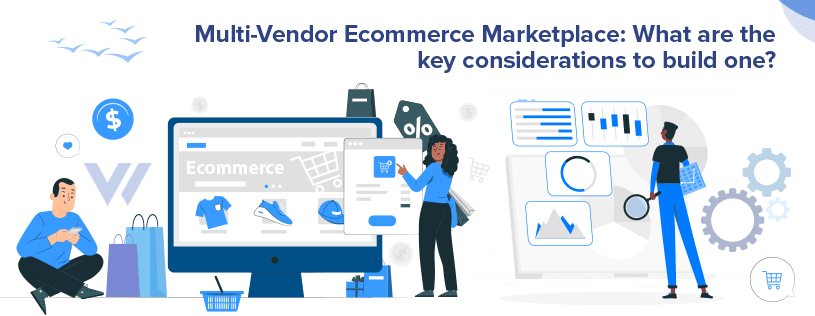Introduction of Multi Vendor Marketplace Development
Building a multi-vendor marketplace can be an exciting and rewarding endeavor, One such solution that has gained significant traction is multi vendor marketplace development offering immense opportunities for entrepreneurs and businesses. However, embarking on this journey requires careful planning and consideration to ensure a successful outcome. This comprehensive guide aims to provide you with the key things you need to consider when building a multi-vendor marketplace. From conceptualization to execution, we’ll explore crucial factors that can contribute to the triumph of your online marketplace.
The Rise of Multi Vendor Marketplace Development

The online marketplace has witnessed a dramatic transformation over the years, shifting from traditional single vendor platforms to multi vendor marketplaces. With the advent of technology and changing customer preferences, consumers are no longer restricted to purchasing from a limited selection of products or brands. Multi vendor marketplaces offer a diverse range of products and services, enabling customers to choose from a vast array of options. This evolution has paved the way for businesses to capitalize on the immense potential of multi vendor marketplace development.
Key Things To Consider Building Multi-Vendor Marketplace
Creating a thriving multi-vendor marketplace requires meticulous attention to several important factors. Let’s dive into the key considerations that will pave the way for your success.
1. Identify Your Target Market
Before delving into the development process, it’s crucial to identify your target market. Understanding your potential customers’ needs, preferences, and pain points will allow you to tailor your platform accordingly. Conduct market research, analyze competitors, and gather insights to gain a comprehensive understanding of your target audience.
2. Choose the Right Platform
Selecting the appropriate platform is paramount for the success of your multi-vendor marketplace. There are various options available, including self-hosted solutions and software-as-a-service (SaaS) platforms. Consider factors such as scalability, customization options, security, and ease of use to make an informed decision that aligns with your business requirements.
3. Establish Clear Vendor Onboarding Processes
Streamlining the vendor onboarding process is essential for creating a positive user experience. Implement user-friendly registration and verification procedures, and provide comprehensive guidelines to help vendors set up their profiles. Prioritize simplicity and efficiency to encourage more vendors to join your marketplace.
4. Ensure Robust Security Measures
Security is a paramount concern for any online marketplace. Protecting sensitive customer and vendor information is crucial to build trust and maintain a reputable platform. Invest in robust security measures, including SSL encryption, secure payment gateways, and regular vulnerability assessments, to safeguard your marketplace from potential threats.
5. Implement an Effective Review and Rating System
Customer trust plays a pivotal role in the success of a multi-vendor marketplace. Implementing a transparent and reliable review and rating system allows customers to make informed purchasing decisions. Ensure that the system is fair, accessible, and encourages both positive and constructive feedback.
6. Foster Seamless Communication Channels
Efficient communication between buyers, vendors, and administrators is vital for resolving queries, addressing concerns, and fostering a sense of community within your marketplace. Implement messaging systems, real-time chat features, and dedicated customer support channels to facilitate smooth communication and build strong relationships.
7. Develop a Robust Search and Filtering Functionality
Enhancing the user experience through advanced search and filtering functionalities is crucial for improving customer satisfaction. Implement a robust search algorithm that enables customers to find products quickly, and provide comprehensive filtering options based on relevant attributes such as price range, brand, and customer ratings.
8. Prioritize Mobile Responsiveness
With the exponential rise in mobile usage, ensuring your multi-vendor marketplace is mobile-responsive is no longer an option but a necessity. Optimize your platform for seamless browsing, product selection, and checkout experiences across various devices and screen sizes.
9. Establish a Transparent Payment System
A secure and transparent payment system is vital for facilitating transactions within your multi-vendor marketplace. Integrate reliable payment gateways that offer multiple payment options, ensuring convenience and trust for both buyers and vendors.
Platform Selection
One of the most important things to consider when building a multi-vendor marketplace is the platform you will use. The platform you choose will determine the features and capabilities of your marketplace. There is a solution for all your need Webnexs
Benefits of Multi-Vendor Marketplaces
Multi-vendor marketplaces have gained significant popularity in recent years, and for good reason. They offer a range of benefits for both vendors and customers alike. Let’s take a closer look at some of the key advantages of multi-vendor marketplaces:
- Increased Product Variety: One of the primary benefits of a multi-vendor marketplace is the wide range of products and services available to customers. With multiple vendors participating, customers have access to a diverse selection of items, allowing them to find exactly what they need without the hassle of visiting multiple websites or stores.
- Enhanced Competition: Multi-vendor marketplaces promote healthy competition among vendors. This competition often leads to lower prices, better quality products, and improved customer service. Vendors strive to offer the best value to attract customers, ultimately benefiting the end-users.
- Efficient Product Discovery: Multi-vendor marketplaces often provide robust search and filtering options, making it easier for customers to find specific products or services. Advanced search algorithms, categorization, and filtering options save customers valuable time and effort by quickly narrowing down their options.
- Trust and Credibility: Established multi-vendor marketplaces are known for their reputation and trustworthiness. Customers feel more confident purchasing from a marketplace that has established trust, as vendors are vetted and their products are typically reviewed and rated by previous customers. This built-in trust and credibility contribute to increased customer satisfaction.
- Lower Costs for Vendors: Creating and maintaining an individual online store can be costly for vendors, especially small businesses or startups. Multi-vendor marketplaces offer a cost-effective solution, as vendors can share the expenses of infrastructure, marketing, and maintenance. This allows vendors to focus more on their core business operations without the burden of extensive overhead costs.
- Larger Customer Base: By joining a multi-vendor marketplace, vendors gain access to a larger customer base than they would have on their own. Established marketplaces attract a significant number of visitors, increasing the visibility and reach of vendors’ products. This exposure can lead to increased sales and brand recognition.
- Improved Marketing Opportunities: Multi-vendor marketplaces often invest in marketing and promotional activities to attract customers to their platform. Vendors benefit from these collective marketing efforts, as they gain exposure to a wider audience without the need for individual marketing campaigns. This allows vendors to leverage the marketplace’s marketing resources and expertise.
- Streamlined Payment Processes: Multi-vendor marketplaces typically handle payment processing on behalf of vendors, simplifying the transaction process. Customers can make purchases from multiple vendors in a single transaction, reducing the hassle of managing separate payments for each vendor. This streamlined payment process enhances the overall user experience.
- Built-in Analytics and Reporting: Many multi-vendor marketplaces provide vendors with access to analytics and reporting tools. These tools offer valuable insights into sales, customer behavior, and market trends. Vendors can use this data to make informed business decisions, optimize their product offerings, and improve their marketing strategies.
- Opportunities for Collaboration: Multi-vendor marketplaces foster collaboration among vendors. Vendors can learn from each other, share resources, and explore potential partnerships or cross-selling opportunities. This collaborative environment can lead to innovation, business growth, and a sense of community among vendors.
In conclusion, multi-vendor marketplaces offer numerous benefits for vendors and customers alike. They provide a wide range of products, promote healthy competition, simplify the shopping experience, and offer cost-effective solutions for vendors. By leveraging the advantages of multi-vendor marketplaces, businesses can expand their reach, increase sales, and create a thriving online ecosystem.
u003cstrongu003eDo I need to have technical expertise to build a multi-vendor marketplace?u003c/strongu003e
Yes, you’ll need some technical expertise to build a multi-vendor marketplace. You’ll need to have knowledge of web development, database management, and payment gateway integration.
u003cstrongu003eCan I build a multi-vendor marketplace using WordPress?u003c/strongu003e
Yes, you can use WordPress to build a multi-vendor marketplace. There are several plugins available, such as WooCommerce, that allow you to create a multi-vendor marketplace.
u003cstrongu003eHow do I attract vendors to my marketplace?u003c/strongu003e
You can attract vendors to your marketplace by offering competitive rates, providing excellent customer service, and promoting your marketplace effectively. You can also reach out to vendors directly and invite them to join your marketplace.
u003cstrongu003eWhat’s the best way to handle product returns and refunds?u003c/strongu003e
You should have a clear policy in place for handling product returns and refunds. This policy should be communicated to both vendors and customers. You may also want to consider using a third-party service to handle returns and refunds.


